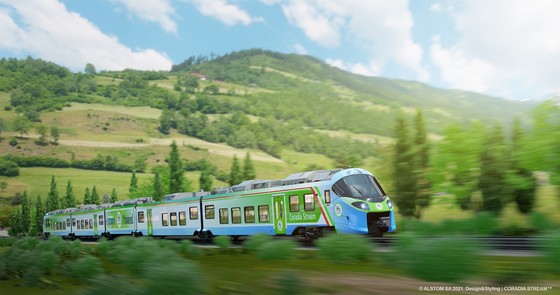Alstom’s growing portfolio of hydrogen traction regional trains

Alstom is proud to be the leading provider of regional fuel-cell trains, such as the Coradia iLint currently in commercial service in Germany. We caught up with Stefano Bavaglia, Alstom’s Product Director for Coradia Stream single-deck solutions, for an overview on the Italian market.
Stefano Bavaglia is Alstom’s Product Director for Coradia Stream single-deck solutions. He is responsible for developing the regional product portfolio and anticipating the future needs of customers, alongside following current projects and tenders. Based in Italy, Stefano likes working with the platform’s multicultural team. In his spare time, he enjoys doing some woodworking, 3D printing and listening to progressive rock.
How is this technology carried over to the Coradia Stream hydrogen fleet for FNM in Northern Italy?
In Italy, leveraging on the experience of Coradia iLint, we have applied hydrogen traction technology to a Coradia Stream electrical train. Our goal was to maximise the synergies of a proven technology with a proven train, while increasing train capacity in order to meet the Italian customer’s needs. The two trains have a different architecture, nevertheless the technology has been easily transferred and adapted. For the Coradia Stream, we have used the power-car configuration where we have concentrated most of the hydrogen equipment.
With the hydrogen power-car, it has been possible to exploit the Coradia Stream platform’s flexibility, selecting a four-car configuration solution as the product base. Capacity was a key requirement for the Italian project; we now have options of up to 300 seats. With this set-up, we can also add more modules and make the train even longer, if needed.
In the end, Alstom hydrogen technology is a basis for developing mobility solutions fit for the future, as we have shown with this Italian project.
Tell us more about putting the first ever hydrogen-powered regional train on rail in Italy
Italy still has many non-electrified lines, and the Italian operator FNM also operates many lines serving mountainous areas. FNM was looking for a sustainable solution, and hydrogen proved to be the better option mainly because of weight and range benefits. The customer had seen the Coradia iLint pre-serial trains in operation in Germany, and they wanted to have a product that was already developed with a proven track record.
In addition, the Lombardia Region and FNM applied a systemic approach to the geographical area where the Coradia Stream hydrogen train will operate. They are aiming to develop hydrogen distribution and usage, creating the so-called “Hydrogen Valley”. So the train will, in addition, be a fundamental element supporting the on-going switch from carbon fossil fuels to hydrogen in that area.
The Coradia Stream hydrogen train will also serve the 2026 Olympic Winter Games in Cortina, showing that mobility solutions fit for the future are possible where there is a clear mandate, as in the Lombardia Region, to decarbonise transport.
Please click here to read the full interview on the Alstom website.
